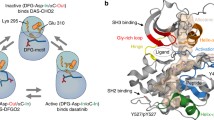Abstract
Here we report the description of the conformational pathways connecting the Lck active and inactive states by means of all-atoms molecular dynamics simulations coupled to an enhancing sampling methodology. By such an approach, we describe the major structural determinants characterizing these large conformational transitions and compare such pathways to those obtained for a similar kinase, i.e. c-Src. Our results show that both the activation and deactivation processes could follow distinct pathways, differentiated by the order by which the A-loop and the C-helix regions rearrange.




Similar content being viewed by others
References
Bromann PA, Korkaya H, Courtneidge SA (2004) The interplay between Src family kinases and receptor tyrosine kinases. Oncogene 23(48):7957–7968. https://doi.org/10.1038/sj.onc.1208079
Parsons SJ, Parsons JT (2004) Src family kinases, key regulators of signal transduction. Oncogene 23(48):7906–7909. https://doi.org/10.1038/sj.onc.1208160
Nika K, Soldani C, Salek M, Paster W, Gray A, Etzensperger R, Fugger L, Polzella P, Cerundolo V, Dushek O, Höfer T (2010) Constitutively active Lck kinase in T cells drives antigen receptor signal transduction. Immunity 32(6):766–777. https://doi.org/10.1016/j.immuni.2010.05.011
Palacios EH, Weiss A (2004) Function of the Src-family kinases, Lck and Fyn, in T-cell development and activation. Oncogene 23(48):7990–8000. https://doi.org/10.1038/sj.onc.1208074
Goldman FD, Ballas ZK, Schutte BC, Kemp J, Hollenback C, Noraz N, Taylor N (1998) Defective expression of p56lck in an infant with severe combined immunodeficiency. J Clin Investig 102(2):421–429. https://doi.org/10.1172/JCI3205
Hubert P, Bergeron F, Ferreira R, Seligmann M, Oksenhendler E, Debre P, Autran B (2000) Defective p56 Lck activity in T cells from an adult patient with idiopathic CD4 lymphocytopenia. Int Immunol 12. https://pdfs.semanticscholar.org/3cc1/eb55b10ee553d570aec2d852e215d5a7e90e.pdf
Lee JE, Cossoy MB, Chau LA, Singh B, Madrenas J (1997) Complexes of peptide:MHC molecules. Signaling upon persistent engagement with Inactivation of lck and loss of TCR-mediated. http://www.jimmunol.org/content/159/1/61
Engen JR, Wales TE, Hochrein JM, Meyn MA, Banu Ozkan S, Bahar I, Smithgall TE (2008) Structure and dynamic regulation of Src-family kinases. Cell Mol Life Sci 65(19):3058–3073. https://doi.org/10.1007/s00018-008-8122-2
Boggon TJ, Eck MJ (2004) Structure and regulation of Src family kinases. Oncogene 23(48):7918–7927. https://doi.org/10.1038/sj.onc.1208081
Yamaguchi H, Hendrickson WA (1996) Structural basis for activation of human lymphocyte kinase Lck upon tyrosine phosphorylation. Nature 384(6608):484–489. https://doi.org/10.1038/384484a0
Manning G, Whyte DB, Martinez R, Hunter T, Sudarsanam S (2002) The protein kinase complement of the human genome. Science 298(5600):1912–1934. https://doi.org/10.1126/science.1075762
Kinnings SL, Jackson RM (2009) Binding site similarity analysis for the functional classification of the protein kinase family. J Chem Inf Model 49(2):318–329. https://doi.org/10.1021/ci800289y
Maier LM, Anderson DE, De Jager PL, Wicker LS, Hafler DA (2007) Allelic variant in CTLA4 alters T cell phosphorylation patterns. PNAS 104(47):18607–18612. https://doi.org/10.1073/pnas.0706409104
Ngoenkam J, Schamel WW, Pongcharoen S (2018) Selected signalling proteins recruited to the T-cell receptor-CD3 complex. Immunology 153(1):42–50. https://doi.org/10.1111/imm.12809
Abraham MJ, van der Spoel D, Lindahl E, Hess B, Team D (2017) GROMACS user manual version 2016.4. www.gromacs.org
Huang W, Lin Z, van Gunsteren WF (2011) Validation of the GROMOS 54A7 force field with respect to β-peptide folding. J Chem Theory Comput 7(5):1237–1243. https://doi.org/10.1021/ct100747y
Mark P, Nilsson L (2001) Structure and dynamics of the TIP3P, SPC, and SPC/E water models at 298 K. J Phys Chem A 105(43):9954–9960. https://doi.org/10.1021/jp003020w
Swope WC, Andersen HC, Berens PH, Wilson KR (1982) A computer simulation method for the calculation of equilibrium constants for the formation of physical clusters of molecules: application to small water clusters. J Chem Phys 76(1):637–649. https://doi.org/10.1063/1.442716
Darden T, York D, Pedersen L (1993) Particle mesh Ewald: an N ·log(N) method for Ewald sums in large systems. J Chem Phys 98(12):10089–10092. https://doi.org/10.1063/1.464397
Bussi G, Donadio D, Parrinello M (2007) Canonical sampling through velocity rescaling. J Chem Phys 126(1):014101. https://doi.org/10.1063/1.2408420
Amadei A, Linssen ABM, Berendsen HJC (1993) Essential dynamics of proteins. Proteins 17(4):412–425. https://doi.org/10.1002/prot.340170408
Hess B (2000) Similarities between principal components of protein dynamics and random diffusion. Phys Rev E 62(6):8438. https://doi.org/10.1103/PhysRevE.62.8438
Bešker N, Amadei A, D’abramo M (2014) Molecular mechanisms of activation in CDK2. J Biomol Struct Dyn 32(12):1929–1935. https://doi.org/10.1080/07391102.2013.844080
Milanetti E, Trandafir AG, Alba J, Raimondo D, D’abramo M (2018) Efficient and accurate modeling of conformational transitions in proteins: the case of c-Src kinase. J Phys Chem 122(38):8853–8860. https://doi.org/10.1021/acs.jpcb.8b07155
Johnson LN, Noble ME, Owen DJ (1996) Active and inactive protein kinases: structural basis for regulation. Cell 85(2):149–158. https://doi.org/10.1016/S0092-8674(00)81092-2
Meng Y, Shukla D, Pande VS, Roux B (2016) Transition path theory analysis of c-Src kinase activation. Proc Natl Acad Sci USA 113(33):9193–9198. https://doi.org/10.1073/pnas.1602790113
Yang S, Banavali NK, Roux B (2009) Mapping the conformational transition in Src activation by cumulating the information from multiple molecular dynamics trajectories. Proc Natl Acad Sci USA 106(10):3776–3781. https://doi.org/10.1073/pnas.0808261106
Acknowledgements
This work was partially funded by Sapienza, University of Rome (Progetto di Ateneo 2018). The authors gratefully acknowledge NVIDIA and CINECA for computational support.
Author information
Authors and Affiliations
Corresponding author
Additional information
Publisher's Note
Springer Nature remains neutral with regard to jurisdictional claims in published maps and institutional affiliations.
Electronic supplementary material
Below is the link to the electronic supplementary material.
Supplementary material 1 (MP4 7174 kb)
Rights and permissions
About this article
Cite this article
Alba, J., Milanetti, E. & D’Abramo, M. On the activation and deactivation pathways of the Lck kinase domain: a computational study. J Comput Aided Mol Des 33, 597–603 (2019). https://doi.org/10.1007/s10822-019-00204-0
Received:
Accepted:
Published:
Issue Date:
DOI: https://doi.org/10.1007/s10822-019-00204-0




